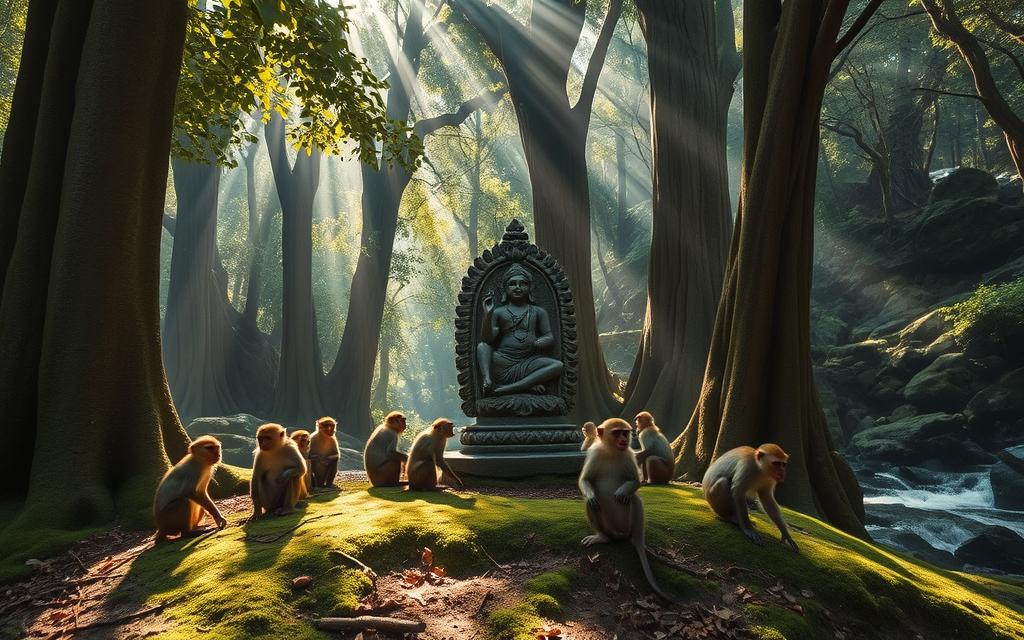
Sacred Monkey Forest Sanctuary: A Historic Journey
Did you know the Sacred Monkey Forest Sanctuary covers about 27 acres? It’s home to around 600 wild Balinese long-tailed macaques. This place in Ubud, Bali, is not just a home for monkeys. It’s also a key spot for both locals and tourists because of its deep cultural and spiritual value12.
Exploring the history of the Sacred Monkey Forest Sanctuary shows its link to Balinese Hindu culture. It also highlights the importance of saving monkeys. This article will take you through its history, the variety of animals, and its deep meaning. You’ll see why the Ubud Monkey Forest is a must-see for those who love nature and culture.
Key Takeaways
- The Sacred Monkey Forest Sanctuary is a major cultural site rich in Balinese heritage.
- It spans 27 acres and hosts about 600 monkeys, drawing numerous visitors each year.
- Three ancient Hindu temples within the sanctuary are key attractions.
- The sanctuary plays a crucial role in local conservation efforts.
- It is easily accessible from popular tourist areas, enhancing its appeal.
- Visitors are encouraged to respect the wildlife while enjoying their experience.
Introduction to the Sacred Monkey Forest Sanctuary
The Sacred Monkey Forest Sanctuary is a special place in Ubud, Bali. It covers about 12.5 hectares and is a key spot for those who love nature and culture. Over 1,200 long-tailed macaques live here, letting visitors see them in their home. It also highlights the importance of wildlife conservation today345.
Every month, 10,000 to 15,000 people visit the sanctuary. This shows how popular it has become since the 1970s, when Bali became a top travel spot34. Walking through, you’ll see 115 tree species that make the area rich in nature35.
There are three old temples inside, from the 14th century. They add to the spiritual and cultural feel of the place4. The local community works hard to keep the sanctuary special. They balance tourism with protecting nature, showing their dedication to wildlife conservation3.
Location and Overview of Ubud Monkey Forest
The Ubud Monkey Forest is in the heart of Ubud. It covers about 12.5 hectares (30.8 acres). This makes it a big highlight for tourists in Bali6. It’s home to around 700 Balinese long-tailed macaques, one of the biggest groups on the island7.
This place lets visitors see these amazing animals up close. It’s also near beautiful and cultural spots that make the visit special.
Walking through, you’ll see three old temples. They are Pura Dalem Agung, Pura Beji, and Pura Prajapati. Each one is full of history and spiritual meaning8. Visitors usually spend 1-2 hours here, looking at local goods like clothes, jewelry, and souvenirs at the Ubud Art Market8.
Over 10,000 people visit the Ubud Monkey Forest every month. This shows how important it is as a place to see Bali’s culture and history8.
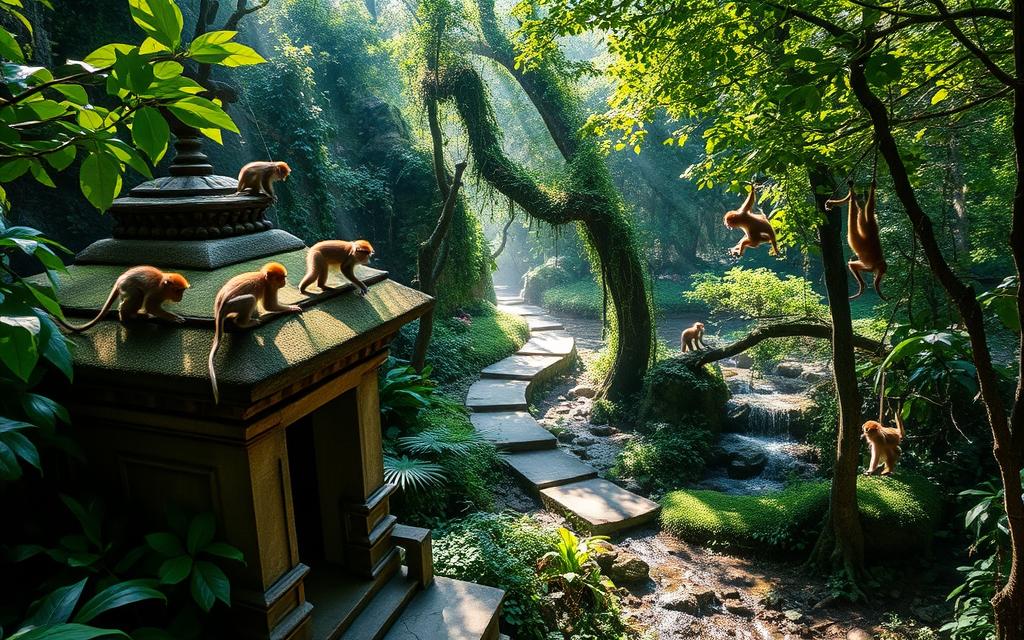
History of the Sacred Monkey Forest Sanctuary
The Sacred Monkey Forest Sanctuary has a long history, going back to the 14th century. It was seen as a sacred place from the start. Today, visitors can see how it was a spot where nature and spirituality met.
Origins and Evolution
Over time, the forest became more than a home for animals. It showed how humans and nature could live together, a key idea in Balinese Hindu culture. The forest is about 12.5 hectares big and is home to 700 to 900 Balinese long-tailed monkeys9
Rituals in the forest show its deep spiritual meaning. The idea of Tri Hita Karana guides local people, linking the divine, nature, and humans. Visitors are asked to respect the monkeys and their home, seeing them as protectors and troublemakers.
Significance in Balinese Hindu Culture
The forest is more than just a place; it’s a site for rituals that connect people with nature. With over 115 tree species, including the Pule Bandak tree, it reflects Balinese Hindu culture and the importance of nature10. This bond encourages people to work together for conservation, showing the importance of tourism that respects culture and wildlife.
By the 20th century, the sanctuary was known for its conservation efforts. It’s now a key place for studying monkey behavior, attracting experts from all over. The mix of spiritual practices, community support, and caring for the environment makes the Sacred Monkey Forest Sanctuary a symbol of Bali’s culture.
Wildlife and Conservation Efforts
The Sacred Monkey Forest Sanctuary is home to over 605 endangered long-tailed macaques. These animals face threats from losing their homes and humans moving in. The forest is a safe place for them and teaches visitors about the need to protect wildlife in Ubud.
Endangered Long-Tailed Macaques
This place is crucial for the survival of endangered long-tailed macaques. It has been around since the 14th century, making it over 600 years old10. Scholars from all over the world come to study these macaques. They learn about their behavior and how they live together10.
Importance of Monkey Conservation
Monkey conservation is very important here. The Sacred Monkey Forest Sanctuary looks after over 115 tree species. These trees are key to the area’s wildlife10. The sanctuary also supports ecotourism. This lets visitors enjoy the local nature while helping the local economy11.
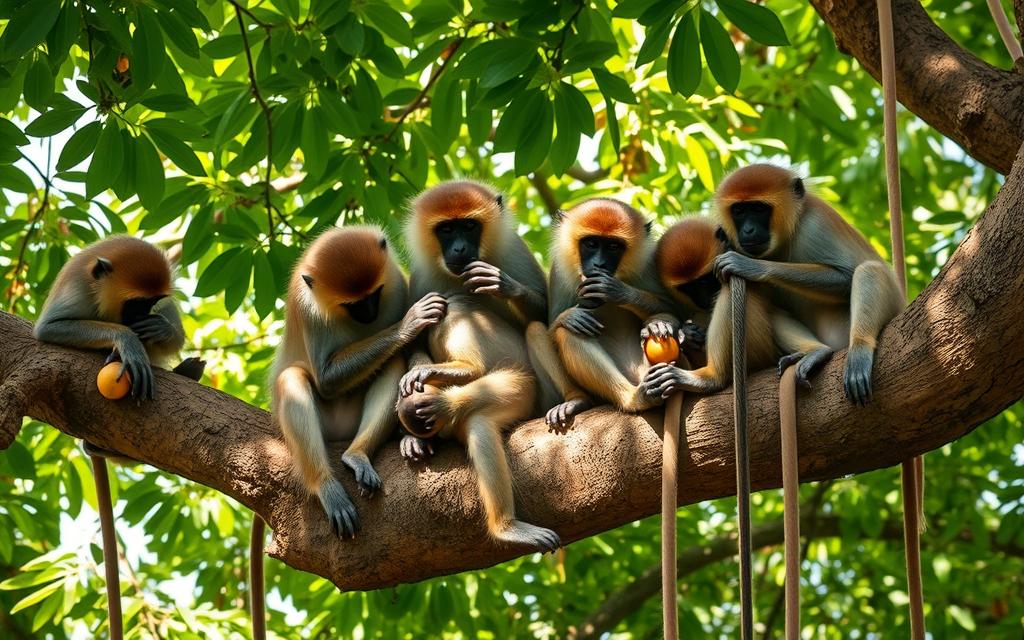
Spiritual Significance of the Forest
The Sacred Monkey Forest Sanctuary is a place of deep spiritual meaning. It shows a strong bond between humans and nature. It covers over 25 acres and is home to more than 1,200 long-tailed macaques12. These animals live in peace among ancient trees and sacred temples.
The forest has three Balinese Hindu temples from the 14th century. They help keep humans and nature in balance13. These temples are key in community ceremonies, showing nature’s power.
People visit to pray and make offerings to the deities. This builds a connection to nature and shows the forest’s sacredness. It’s a place where humans and monkeys live together in peace, showing the value of respecting nature.
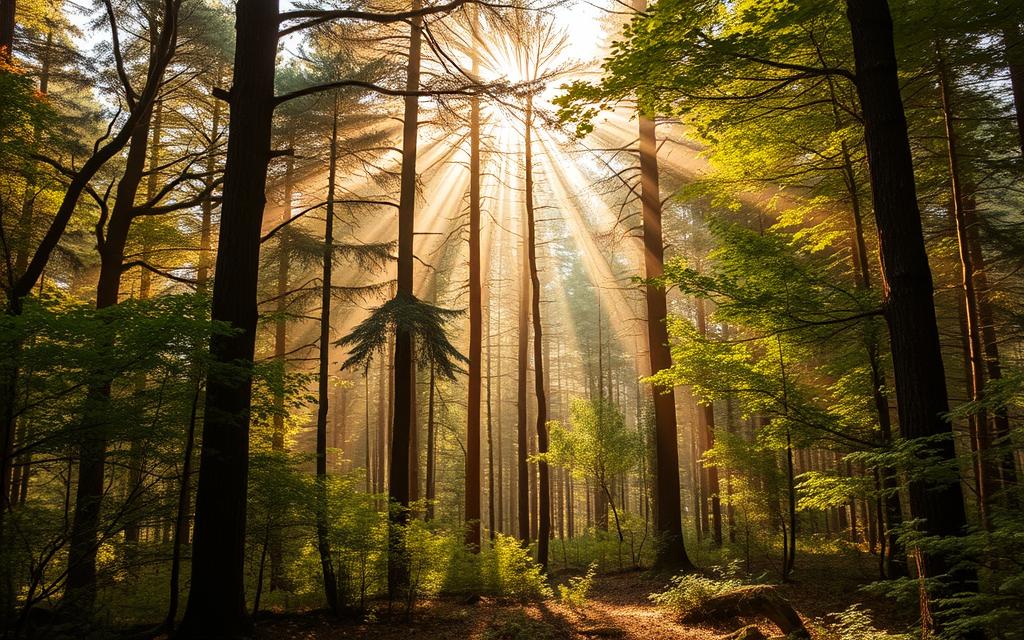
The Khayangan Tiga Temple Complex
The Khayangan Tiga temple complex is a key cultural spot in the Sacred Monkey Forest Sanctuary. It has three important 14th-century temples. These temples are vital to Balinese spirituality. Some parts are closed to visitors, but you can still see the beautiful design and history from afar.
Visitors love the greenery around the Khayangan Tiga temples. It shows how nature and spirituality blend in Balinese culture. Each temple has its own special meaning, adding to the forest’s beauty and wildlife.
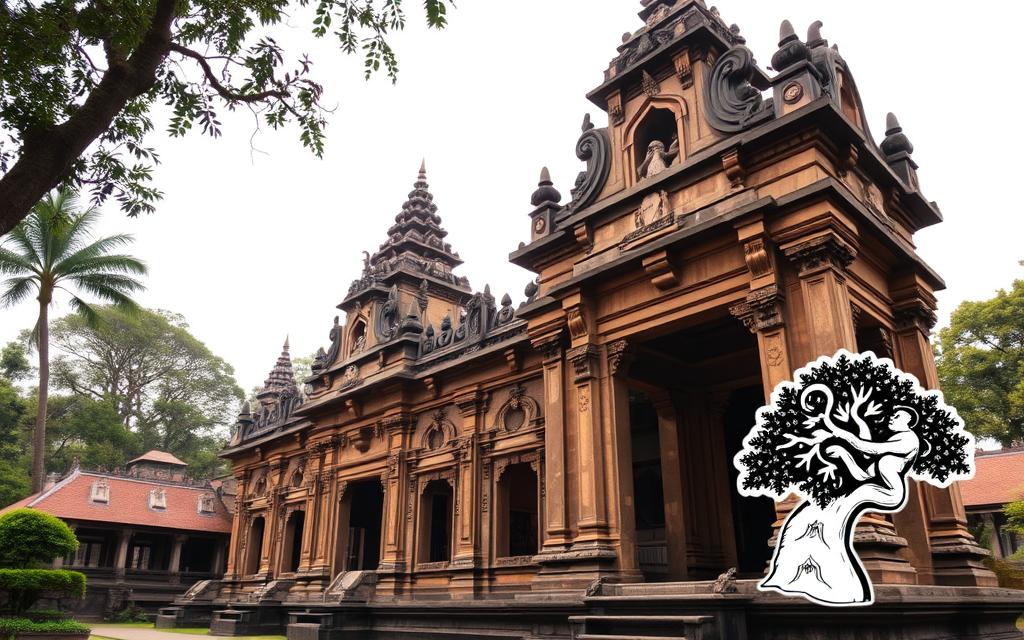
This place shows Bali’s amazing architecture and connects people with their gods. To really get the Khayangan Tiga temple complex, you need to understand Balinese culture and how nature affects their spiritual life141516.
Flora of the Ancient Forest Sanctuary
The Monkey Forest is home to over 186 tree species. These trees make the Ubud Monkey Forest rich in life. It’s not just for the macaques; it’s also a place for Balinese traditions.
The Majegan tree is special. It’s only used for building shrines. This shows how important trees are in spiritual life and ceremonies.
Tree Species and Their Cultural Importance
The Ubud Monkey Forest has many tree species. They show how nature and Balinese spirituality are connected. Trees are seen as sacred and are key to the island’s spiritual life.
Rituals are done to honor the spirits in these trees. This deepens the bond between nature and spirituality in Balinese culture. Visitors see the beauty and learn about the trees’ role in culture and spirituality.
Connection Between Nature and Spirituality
The Monkey Forest shows how nature and spirituality are linked in Balinese life. Trees are seen as sacred, keeping balance between the physical and spiritual worlds. Rituals celebrate this bond, promoting harmony for spiritual health.
Visiting this place helps you grasp the deep respect for nature and spiritual beliefs in Bali. It shows the importance of trees in their culture.
Seeing the flora in this ancient place shows how trees are key in Balinese life. They play a big role in daily life and spiritual practices. Visitors leave with a deeper respect for life, its ecosystems, and the traditions tied to these trees1718.
Experiences and Activities in the Sanctuary
At the Sacred Monkey Forest Sanctuary, there are many fun things to do for all ages. This place is over 14th century old and covers 27 acres. It’s home to about 1,200 playful monkeys. You can watch them up close and take great photos1920.
There are lots of things to do in Ubud, like guided tours that teach you about the place and its culture. The sanctuary is open every day from 9 am to 6 pm. This gives you about 2.5 hours to explore1921. Don’t bring food or drinks to keep the visit safe.
Inside the sanctuary, you’ll see beautiful places like the Holy Spring Temple and the Dalem Agung Padangtegal Temple. These spots are full of spirituality and history21. Being in nature and learning about culture makes for unforgettable moments.
The Role of the Sanctuary in Bali Tourism
The Sacred Monkey Forest Sanctuary is a big draw in Bali’s tourism scene. It’s home to over 700 Balinese long-tailed monkeys that entertain visitors with their fun antics22. The sanctuary covers 12 hectares and blends beauty with culture22. With nearly 1,260 macaque monkeys, it’s a top spot for tourists from around the world23.
Visiting is a joy, as it’s open daily from 8:30 AM to 5:30 PM23. You’ll see three ancient temples in this green space, showing Bali’s deep history and the importance of the Monkey Forest in tourism23. Adults pay about $8 CAD to enter, making it affordable for many22.
The sanctuary promotes responsible tourism. By following rules, you help protect the wildlife and nature. Every month, 10,000 to 15,000 people visit, showing its key role in Bali’s tourism23.
Conclusion
The Sacred Monkey Forest Sanctuary shows the mix of nature and culture in Bali. It’s a place where history and nature meet. The sanctuary has been important to Ubud for a long time.
It covers about 27 acres, protecting wildlife and ancient temples like Pura Dalem Agung, Pura Beji, and Pura Prajapati. This makes it a key spot for learning about nature and spirituality2425.
Inside, you’ll see over 700 long-tailed macaques. This shows how important it is to protect wildlife. It also talks about how tourists and animals can live together26. Guides there share lots of interesting facts, making your visit more meaningful24.
Going to the Sacred Monkey Forest Sanctuary is more than just fun. It’s a chance to learn about Balinese culture and how to take care of the environment. You’ll understand the sanctuary’s history and how you can help protect it25.
FAQ
What is the Sacred Monkey Forest Sanctuary?
The Sacred Monkey Forest Sanctuary is a 27-acre area in Ubud, Bali. It’s home to over 600 long-tailed macaques. It mixes nature with Balinese Hindu beliefs.
Why is the Monkey Forest significant in Balinese culture?
It’s a key part of Balinese Hindu culture. The sanctuary follows Tri Hita Karana, which means balance between humans, nature, and the divine. It’s a sacred place for spiritual rituals.
How does the sanctuary contribute to monkey conservation?
The sanctuary helps protect endangered long-tailed macaques. It offers a safe home and teaches visitors about saving wildlife and biodiversity.
Can visitors interact with the monkeys in the forest?
Yes, visitors can meet the monkeys safely and with respect. Seeing their playful nature is a big part of the sanctuary’s charm.
What is the Khayangan Tiga Temple Complex?
The Khayangan Tiga Temple Complex has three 14th-century temples. Some areas are off-limits, but the temples show the link between Balinese culture and nature.
What kind of flora can be found in the Monkey Forest?
The sanctuary has 115 tree species. Many trees are important in Balinese rituals, like the Majegan tree for building shrines.
What experiences can visitors enjoy at the Sacred Monkey Forest Sanctuary?
Visitors can go on guided tours, take photos, and dive into the culture. They can walk through peaceful paths and watch the macaques in their home.
How does the sanctuary impact Bali’s tourism?
The sanctuary is a big draw for tourists worldwide. It mixes nature with culture, promoting eco-tourism and responsible travel. This helps visitors appreciate the environment more.
Source Links
- https://www.anywhere.com/indonesia/destinations/ubud/tours/monkey-forest
- https://baligram.me/blog/ubud-monkey-forest-sanctuary-a-sacred-place-where-monkeys-rule
- https://en.wikipedia.org/wiki/Ubud_Monkey_Forest
- https://travelsetu.com/guide/sacred-monkey-forest-sanctuary-tourism/sacred-monkey-forest-sanctuary-tourism-history
- https://www.pelago.com/en/articles/sacred-monkey-forest-sanctuary/
- https://theculturetrip.com/asia/indonesia/articles/a-history-of-ubud-monkey-forest-in-60-seconds
- https://balicheapesttours.com/ubud-monkey-forest.html
- https://foreverbreak.com/travel/indonesia/bali/ubud/sacred-monkey-forest-sanctuary/
- https://herotraveler.com/shipped_away/story/ubud-monkey-forest
- https://monkeyforestubud.com/about-us/
- https://www.chrie.org/assets/docs/JHTC-case-notes/JHTC-vol-7/JHTC_Vol7Issue3-Bragg_case.pdf
- https://medium.com/digital-global-traveler/the-entrancing-sacred-monkey-forest-sanctuary-of-bali-b7e695aca76d
- https://www.alfredinbali.com/ubud-monkey-forest-1/
- https://www.triphobo.com/blog/temples-in-bali
- https://khayangan.net/2016/04/hello-world/
- https://en.wikipedia.org/wiki/Balinese_temple
- https://ladyhattan.com/ubud-bali-indonesia-inside-sacred-monkey-forest-sanctuary/
- https://villaamrita.com/monkey-forest-ubud-in-bali/
- https://whatkirstydidnext.com/travel/visiting-the-sacred-monkey-forest-sanctuary-in-ubud/
- https://guideyourtravel.com/read-this-before-visiting-the-monkey-forest-in-ubud-bali/
- https://www.tripoto.com/ubud/places-to-visit/sacred-monkey-forest-sanctuary
- https://www.ramblynjazz.com/post/monkey-business-a-visit-to-ubud-s-famous-sanctuary
- https://pickyourtrail.com/attractions/ubud-monkey-forest-bali
- https://www.globetrotterjourney.com/the-sacred-monkey-forest-in-ubud-bali/
- https://www.travelphotographyguru.com/travel-blogs/sacred-monkey-forest-sanctuary
- https://come2indonesia.com/journey-to-ubud-bali-indonesia/